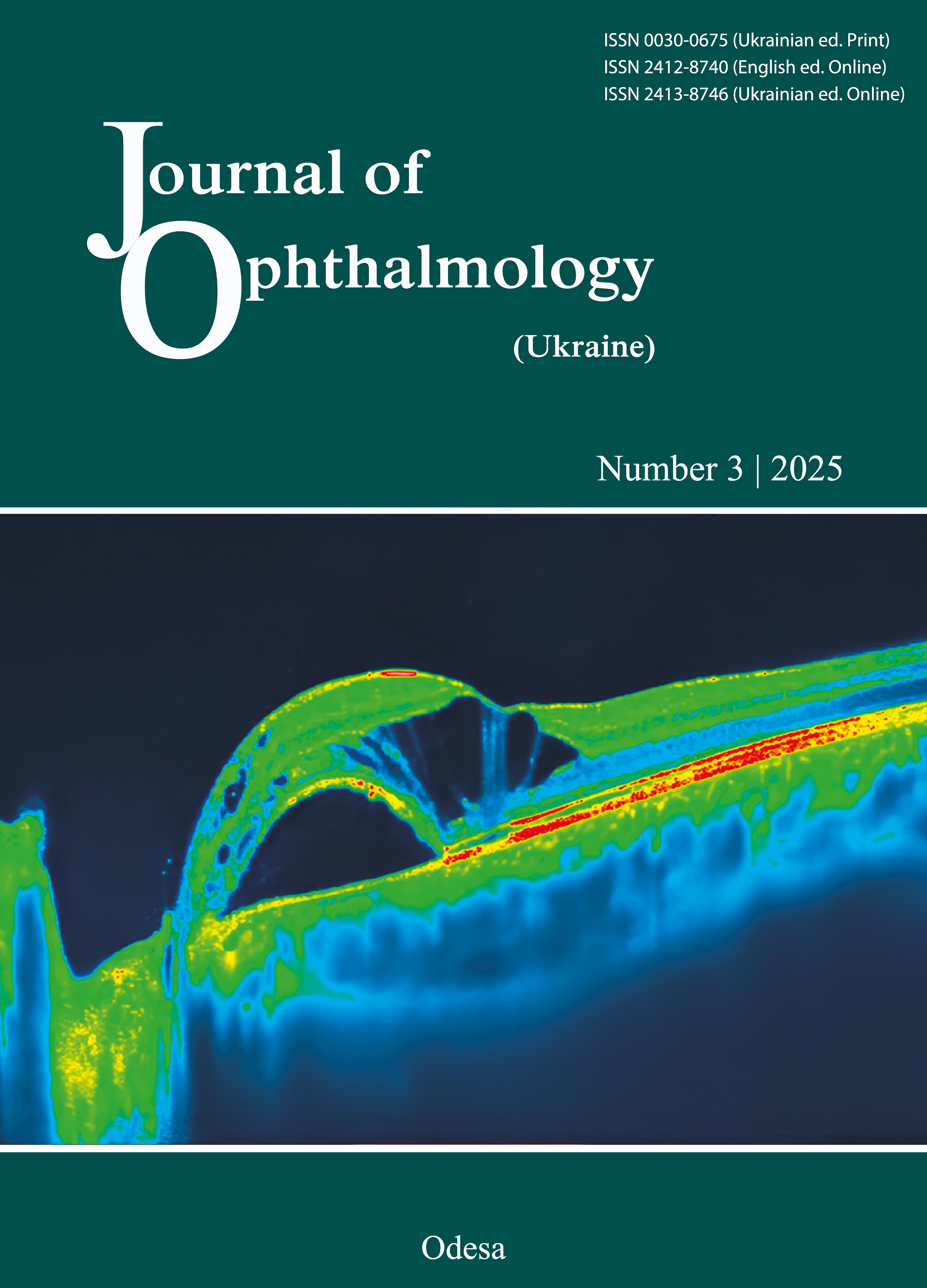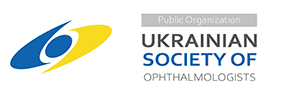In vitro and in vivo regenerative processes resulting from the effect of experimental samples of synthetic polyvinyl formal based hydrogel implants
DOI:
https://doi.org/10.31288/oftalmolzh202533544Keywords:
PVF, hydrogel implants, orbit, regeneration, in vitro, in vivo, biocompatibility, implantationAbstract
Purpose: To experimentally examine in vitro and in vivo regenerative processes resulting from the effect of experimental samples of synthetic (poly)vinyl formal (PVF) based hydrogel implants.
Material and Methods: Scanning electron microscopy (SEM) analysis; Vero cell culture evaluation of in vitro regenerative processes by the wound-healing assay; evaluation of in vivo regenerative processes in the rabbit ocular and crest tissues resulting from the effect of experimental samples of synthetic PVF based hydrogel implants. Experimental studies of hybrid hydrogels were conducted in 20 Chinchilla rabbits (age, 5–6 months and weight, 2–3 kg) that were maintained and fed under similar conditions.
Results: The most active regeneration of the damaged Vero cell monolayer (with a wound closure percentage of 91%) resulted from the effect of the sample of PVF/AuNP (12.06 µg/g) hydrogel, followed by PVF-based hydrogel and PVF-based hydrogel impregnated with poly(N-isopropylacrylamide) (PNIPAM). In an in vivo study of local effects after implantation of PVF/AuNP (12.06 µg/g) hydrogel in the scleral sac, orbital tissue or below the crest intradermally, the rabbits who underwent this implantation exhibited mild edema of postoperative suture site and adjacent conjunctiva which reduced on day 10 and practically disappeared on days 17-19. Histomorphological studies of responses of the rabbit orbital and crest tissue to the hydrogel implant found neither implant resorption nor acute inflammation of the surrounding tissue.
Conclusion: Our in vitro and in vivo study of regenerative processes resulting from the effect of experimental samples of synthetic PVF based hydrogel implants demonstrated that PVF/AuNP (12.06 µg/g) hydrogel is highly biocompatible and had promise as an implant material.
References
Lanigan A, Lindsey B, Maturo S, Brennan J, Laury A. "The Joint Facial and Invasive Neck Trauma (J-FAINT) Project, Iraq and Afghanistan: 2011-2016. Otolaryngol Head Neck Surg. 2017 Oct;157(4):602-607. https://doi.org/10.1177/0194599817725713
Bordbar-Khiabani A, Gasik M. Smart hydrogels for advanced drug delivery systems. Int J Mol Sci. 2022 Mar 27;23(7):3665. https://doi.org/10.3390/ijms23073665
Clasky AJ, Watchorn JD, Chen PZ, Gu FX. From prevention to diagnosis and treatment: Biomedical applications of metal nanoparticle-hydrogel composites. Acta Biomater. 2021 Mar 1;122:1-25. https://doi.org/10.1016/j.actbio.2020.12.030
Chugh H, Sood D, Chandra I, Tomar V, Dhawan G, Chandra R. Role of gold and silver nanoparticles in cancer nano-medicine. Artif Cells Nanomed Biotechnol. 2018;46(sup1):1210-1220. https://doi.org/10.1080/21691401.2018.1449118
Crezee J, Franken NAP, Oei AL. Hyperthermia-based anti-cancer treatments. Cancers (Basel). 2021 Mar 12;13(6):1240. https://doi.org/10.3390/cancers13061240
Darweesh RS, Ayoub NM, Nazzal S. Gold nanoparticles and angiogenesis: molecular mechanisms and biomedical applications. Int J Nanomedicine. 2019 Sep 19;14:7643-7663. https://doi.org/10.2147/IJN.S223941
Grant SA, Zhu J, Gootee J, Snider CL, Bellrichard M, Grant DA. Gold Nanoparticle-Collagen Gels for Soft Tissue Augmentation. Tissue Eng Part A. 2018 Jul;24(13-14):1091-1098. https://doi.org/10.1089/ten.tea.2017.0385
Habib LA, Yoon MK. Patient specific implants in orbital reconstruction: A pilot study. Am J Ophthalmol Case Rep. 2021 Oct 19;24:101222. https://doi.org/10.1016/j.ajoc.2021.101222
Heo DN, Ko WK, Bae MS, Lee JB, Lee DW, Byun W, et al. Enhanced bone regeneration with a gold nanoparticle-hydrogel complex. J Mater Chem B. 2014; 2, 1584-1593. https://doi.org/10.1039/C3TB21246G
Ho TC, Chang CC, Chan HP, Chung TW, Shu CW, Chuang KP, et al. Hydrogels: Properties and applications in biomedicine. Molecules. 2022 May 2;27(9):2902. https://doi.org/10.3390/molecules27092902
ISO 10993-12, ISO 10993-12:2012 Biological evaluation of medical devices - Part 12: Sample preparation and reference materials, 2014 (2014).
Jafari M, Paknejad Z, Rad MR, Motamedian SR, Eghbal MJ, Nadjmi N, et al. Polymeric scaffolds in tissue engineering: a literature review. J Biomed Mater Res B Appl Biomater. 2017 Feb;105(2):431-459. https://doi.org/10.1002/jbm.b.33547
Kim B, Lee JS. Thermally reversible shape transformation of nano-patterned PNIPAAm hydrogel. Polym Bull. 2021;78: 3353-3361. https://doi.org/10.1007/s00289-020-03276-3
Li H, Pan S, Xia P, Chang Y, Fu C, Kong W, et al. Advances in the application of gold nanoparticles in bone tissue engineering. J Biol Eng. 2020 May 6;14:14. https://doi.org/10.1186/s13036-020-00236-3
Lee D, Heo DN, Nah HR, Lee SJ, Ko WK, Lee JS, et al. Injectable hydrogel composite containing modified gold nanoparticles: implication in bone tissue regeneration. Int J Nanomedicine. 2018 Nov 1;13:7019-7031. https://doi.org/10.2147/IJN.S185715
Liang CC, Park AY, Guan JL. In vitro scratch assay: a convenient and inexpensive method for analysis of cell migration in vitro. Nat Protoc. 2007;2(2):329-33. https://doi.org/10.1038/nprot.2007.30
Memic A, Alhadrami HA, Hussain MA, Aldhahri M, Al Nowaiser F, Al-Hazmi F, et al. Hydrogels 2.0: improved properties with nanomaterial composites for biomedical applications. Biomed Mater. 2015 Dec 23;11(1):014104. https://doi.org/10.1088/1748-6041/11/1/014104
Pinho RA, Haupenthal DPS, Fauser PE, Thirupathi A, Silveira PCL. Gold nanoparticle-based therapy for muscle inflammation and oxidative stress. J Inflamm Res. 2022 May 31;15:3219-3234. https://doi.org/10.2147/JIR.S327292
Ratemi E. 5-pH-responsive polymers for drug delivery applications. In: Makhlouf ASH, Abu-Thabit NY, editors. Woodhead publishing series in biomaterials, stimuli responsive polymeric nanocarriers for drug delivery applications, V.1. Woodhead Publishing; 2018. p.121-141. https://doi.org/10.1016/B978-0-08-101997-9.00005-9
Rodriguez LG, Wu X, Guan JL. Wound-healing assay. Methods Mol Biol. 2005;294:23-9. https://doi.org/10.1385/1-59259-860-9:023
Samchenko YuM, Dybkova SM, Maletskyi AP, Kernosenko LO, Artiomov OV, Gruzina TG, et al. In vitro and in vivo study of the biocompatibility and adjacent soft tissue response to synthetic polyvinylformal hydrogel implant. Oftalmol Zh. 2024; 110:45-51. https://doi.org/10.31288/oftalmolzh202434551
Samchenko YuM, Dybkova SM, Reznichenko LS, Kernosenko LO, Gruzina TG, Poltoratska TP, et al. Synthesis and study on antimicrobial properties of hydrogel materials for maxillo-facial Surgery. Him Fiz Tehnol Poverhni. 2024;15:110-118. https://doi.org/10.15407/hftp15.01.110
Suarez-Arnedo A, Torres Figueroa F, Clavijo C, Arbeláez P, Cruz JC, Muñoz-Camargo C. An image J plugin for the high throughput image analysis of in vitro scratch wound healing assays. PLoS One. 2020 Jul 28;15(7):e0232565. https://doi.org/10.1371/journal.pone.0232565
Tan HL, Teow SY, Pushpamalar J. Application of metal nanoparticle-hydrogel composites in tissue regeneration. Bioengineering. 2019; 6(1):17. https://doi.org/10.3390/bioengineering6010017
Xian S, Webber MJ. Temperature-responsive supramolecular hydrogels. J Mater Chem B. 2020;8: 9197-9211. https://doi.org/10.1039/D0TB01814G
Yesildag C, Zhang Z, Ren F, Vicente GD, Lensen MC. Nano- and micro-patterning of gold nanoparticles on PEG- based hydrogels for controlling cell adhesion. In: Seehra MS, Bristow AD, editors. Noble andprecious metals - properties, nanoscale effects and applications. 2018. https://doi.org/10.5772/intechopen.71548
Wu Y, Wang H, Gao F, Xu Z, Dai F, Liu W. An injectable supramolecular polymer nanocomposite hydrogel for prevention of breast cancer recurrence with theranostic and mammoplastic functions. Adv Funct Mater. 2018;28(21):1801000. https://doi.org/10.1002/adfm.201801000
Downloads
Published
How to Cite
Issue
Section
License
Copyright (c) 2025 Samchenko Yu.M., Maletskiy A.P., Dybkova S.M., Gruzina T.G., Rieznichenko L.S., Podolska V.I., Kernosenko L.O., Artemov O.V., Poltoratska T.P., Zholobak N.M., Kolesnichenko V.G.

This work is licensed under a Creative Commons Attribution 4.0 International License.
This work is licensed under a Creative Commons Attribution 4.0 International (CC BY 4.0) that allows users to read, download, copy, distribute, print, search, or link to the full texts of the articles, or use them for any other lawful purpose, without asking prior permission from the publisher or the author as long as they cite the source.
COPYRIGHT NOTICE
Authors who publish in this journal agree to the following terms:
- Authors hold copyright immediately after publication of their works and retain publishing rights without any restrictions.
- The copyright commencement date complies the publication date of the issue, where the article is included in.
DEPOSIT POLICY
- Authors are permitted and encouraged to post their work online (e.g., in institutional repositories or on their website) during the editorial process, as it can lead to productive exchanges, as well as earlier and greater citation of published work.
- Authors are able to enter into separate, additional contractual arrangements for the non-exclusive distribution of the journal's published version of the work with an acknowledgement of its initial publication in this journal.
- Post-print (post-refereeing manuscript version) and publisher's PDF-version self-archiving is allowed.
- Archiving the pre-print (pre-refereeing manuscript version) not allowed.












